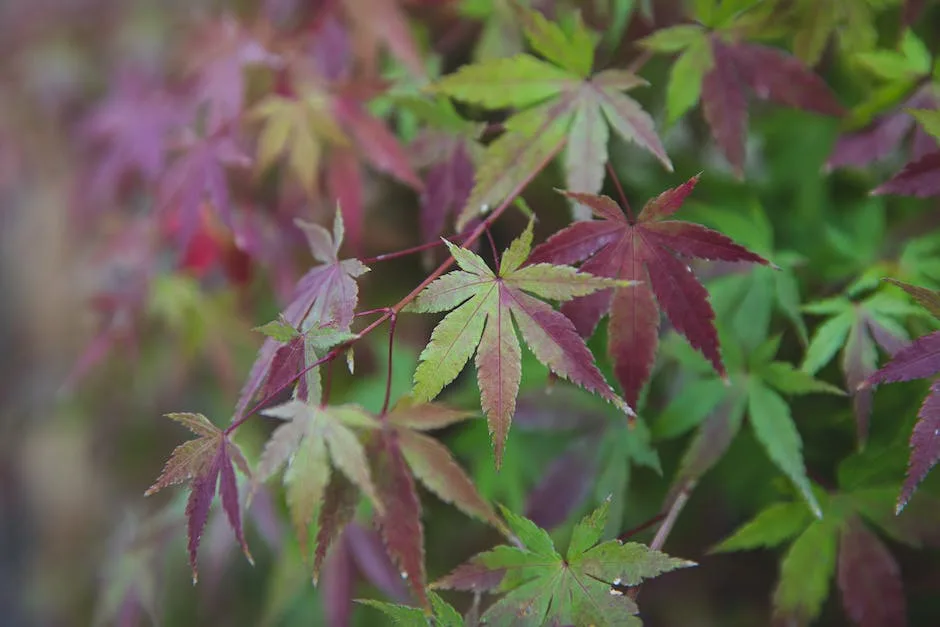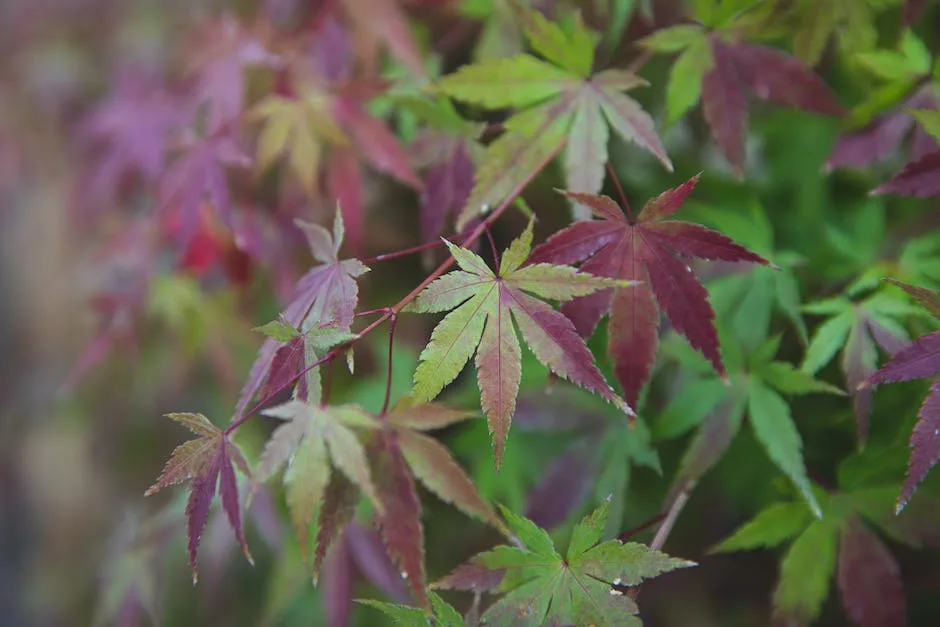Invasive roots are a problem for many homeowners. Japanese maples are no exception. The roots of these trees often grow beyond the tree’s drip line, or edge of the canopy. This can damage lawns, patios, sidewalks, and even foundations. The roots can also be a nuisance when trying to plant other things in the area.
Japanese maple trees have shallow, fibrous roots that spread wide close to the ground, making them well-suited for growing in small spaces. However, these roots can be invasive, and may damage nearby paving or foundations if left unchecked.
Can Japanese maple be planted close to house?
Japanese maples are ideal for the north and east sides of the house because they only need morning sun. Many cultivars don’t grow taller than eight feet, so they’ll fit nicely in a corner next to the house, underneath a window or eve, or beneath a medium to large shade tree.
A root system of a mature 6-8 foot Crimson Queen Japanese Maple allowed to develop naturally without any restrictions can spread out over 12 feet wide and up to 3 feet deep. This is a huge root ball and probably not anything a home owner without heavy equipment would be able to tackle.
Are Japanese maples considered invasive
Japanese maples are beautiful trees that can add a touch of elegance to any garden. However, they can also be very invasive, and if not properly managed, can quickly take over an area. If you’re concerned about the potential impact of a Japanese maple on your property, it’s best to err on the side of caution and remove the tree.
Tree roots are attracted to areas with friable soils and mulch because they are easy to grow in. If tree roots are left unchecked, they can damage a house foundation. To prevent this, it is important to regularly check the tree roots and trim them back if necessary.
Where should you not plant a Japanese maple?
Japanese maples are beautiful trees that can add interest to any landscape. While they can be grown in poor soil, their growth rate is much slower and trees are more likely to experience stress. Ideally, they should be placed in a spot with dappled shade. Japanese maple foliage is prone to leaf scorch in hot and dry locations in full sun.
There are a few types of trees with non-invasive roots that are best for your yard. Some of these include the Japanese Maple, Crape Myrtle, Eastern Redbud, and Cornus Mas. These trees are all relatively small and won’t damage your yard or home if their roots spread.
Can I plant a maple tree close to my house?
A maple tree should not be planted 10 feet from a home. The tree will eventually get too big and the roots will damage the foundation of the house. Instead, the tree should be planted 20 or more feet from the house. This will provide the house with shade without damaging the foundation.
Trees are an important part of the ecosystem, but some species, like the silver maple, can be quite invasive. Their roots can damage driveways, pavement, foundations, and pipes as they grow larger. If you’re concerned about the potential damage they may cause, it’s best to avoid planting them in your yard.
How aggressive are maple tree roots
Tree roots are very important for the health of the tree. They not only help to anchor the tree in the ground, but also help to absorb water and nutrients from the soil.
Maple trees are especially aggressive when it comes to their roots, and can develop an incredible network of surface feeder roots. These roots seek out moisture and nutrients, and can out-compete the roots of annuals and perennials by virtue of their stronger drawing power.
Weeping Japanese maples (Acer palmatum var. dissectum) grow slowly and typically don’t mature wider than 10 feet. Plant such smaller-maturing cultivars no closer than 6 feet from a house’s foundation, sidewalk or driveway. The measurement is made from the tree trunk to the structure.
Why are Japanese maples invasive?
Md. Department of Natural Resources. They provide little benefits to native wildlife and can displace native plant species These factors contribute to the species being listed as invasive in Maryland.
Morton Miyabe Maple trees are not invasive and would be a good substitute for ash trees where ash borer problems exist. Two excellent selections are the ‘State Street’ and ‘Rugged Ridge’ varieties.
What trees should not be planted close to a house
Some trees you should not plant in your property are Red Oak, Sweetgum, Bradford Pear, Lombardy Poplar, Ginkgo biloba, Eucalyptus, Mulberry, and Weeping Willow. Red Oak is messy and Sweetgum is known for dropping its leaves. Bradford Pear and Lombardy Poplar are both fast-growing trees that can quickly become a nuisance. Ginkgo biloba and Eucalyptus are both non-native, invasive species. Mulberry and Weeping Willow are both water-hungry trees that can quickly lead to drainage problems.
There are a few tree species that are notorious for damaging foundations and causinglong-term problems for homeowners. These include willow trees, poplars, cottonwoods, aspens, silver maples, Norway maples, and American elm trees, among others. Smaller trees with shallow roots, however, pose little risk to your home. Japanese maple trees, for instance, are safe to plant relatively close to your house.
How much space does Japanese maple need?
When choosing plants for your garden, it’s important to know how much space you have to work with. This will help you determine which varieties are a possible fit. An area with a width of at least five feet is a good starting point for a dwarf tree to spread out. You’ll need to increase the size of the planned footprint accordingly if you end up choosing a larger tree.
A Maple tree is a perfect addition to any front yard. The Sun Valley Maple is a fast-growing variety that provides good shade and is resistant to Leafhoppers. This tree is a great multitasker that will add curb appeal and value to your home.
Can Japanese Maple take full sun
Japanese maples are gorgeous trees that can add a lot of character to your landscape. They are relatively easy to care for, but there are a few things to keep in mind when it comes to their light needs. In general, they prefer full sun in all but the southernmost portions of their range. However, they will also do well in dappled or afternoon shade. This is especially true if you are growing them for their foliage color, as they will need some sun to bring out their best hues. Just how much sun you give them can vary depending on the variety you choose. So, be sure to do your research before planting.
One hundred year old Japanese maples are extremely rare and beautiful. They are living sculptures that are prized by collectors and landscapers alike. The oldest known Japanese maple is over three hundred years old and is located in Kyoto, Japan. While it is possible for Japanese maples to live to be over one hundred years old, they typically grow just one to two feet per year. This slow growth rate is due to the plant’s shallow root system and its need for moist, well-drained soil. If you are lucky enough to have a one hundred year old Japanese maple on your property, be sure to take care of it and give it the attention it deserves!
What is the best tree for a small front yard
There are a variety of plant varieties that are perfect for small yards or areas. Crabapple, redbud, crape myrtle, and flowering dogwood are just a few of the beautiful options that won’t take up too much space. Kousa dogwood, saucer magnolia, and fringe tree are also perfect for smaller areas. Each of these plants has its own unique beauty and charm that will add interest and dimension to any yard.
Generally, when pruning roots you should stay 5 times the diameter away from the base of the tree. So, if your tree has a diameter of 3 feet, you should only cut tree roots 15 feet away from the tree. Mark the area you’ll cut, and dig a hole all the way around the root until it is completely exposed.
What is the most low maintenance tree
Here are five trees that require little to no maintenance:
1. Jacaranda – If you live on a property that has a large outdoor space that gets tons of sun, then the jacaranda is a good choice for your property.
2. Japanese Maple Trees – These trees are known for their beautiful foliage, and they don’t require much in the way of maintenance.
3. Serviceberry – The serviceberry is a low-maintenance tree that is perfect for small yards or gardens.
4. Crape Myrtle – The crape myrtle is a heat-tolerant tree that is also very drought-resistant.
5. Magnolia – The magnolia is a beautiful tree that is relatively easy to care for.
Dwarf Japanese maples are the perfect trees for small spaces. They are slow-growing and compact, and their leaves are small. They are also very easy to care for.
Can I keep a maple tree small
Pruning a maple tree on a regular basis can help keep it the desired size, and prevent it from encroaching on its neighbours. Pruning can also help the tree develop a sound branch structure. By carefully removing branches, structural issues in a tree can be reduced or eliminated.
Japanese maples are small to medium-sized trees that are popular for their ornamental value. They come in a range of sizes, from 2 to 30 feet tall, and a variety of different forms, including weeping, rounded, dwarf, mounding, upright, and cascading. Choosing the right one for your needs means knowing how you want to use it. For example, if you’re looking for a tree to provide shady relief in a small space, a dwarf or weeping variety would be a good option. If you want a tree that will make a big impact in your landscape, an upright or cascading variety would be a better choice.
Can tree roots penetrate concrete
While tree roots typically don’t penetrate solid concrete, soil movement from tree roots can cause buckling in paved areas like walkways. To avoid costly damage, it’s important to take preventive measures.
A root barrier is a good solution for preventing further damage from tree roots. This is especially important before planting trees. Root barriers redirect the growth of tree roots so they don’t grow near your property’s foundation, gas lines, or water pipes. There are two types of root barriers: chemical and mechanical.
Can tree roots break through concrete
If you have trees near your concrete surfaces, be aware that their roots could potentially cause damage to the concrete. Roots can push through cement, causing cracks and potentially expensive damage. Keep an eye on your trees and if you notice any roots pushing through the concrete, take action to prevent further damage.
Invasive tree roots are a common problem for many homeowners. Trees and plants with the most invasive roots include: silver maple tree, southern magnolia, willow tree, hybrid poplar tree, and mint.
Conclusion
There are conflicting opinions on whether Japanese maple tree roots are invasive. Some sources claim that the roots are not very aggressive and are unlikely to damage foundations or underground pipes. Other sources claim that the roots can be aggressive and may cause problems for homeowners. Ultimately, it is up to the homeowner to decide whether or not to plant a Japanese maple tree based on their own research and observations.
Japanese Maple tree roots are not known to be invasive. In fact, they are quite the opposite. Japanese Maple roots are known to be quite shallow, meaning they are less likely to cause damage to your foundation or underground plumbing.
I’ve always been drawn to trees.
As a kid, I spent most of my free time outside, climbing, exploring, and trying to figure out the names of the trees around me.
That early curiosity eventually led me to study arboriculture and horticulture at Michigan State.
Later, I completed a degree in forestry at the University of Michigan.
I’ve been working in tree care and education ever since.
These days, I enjoy helping people learn more about the trees in their own backyards.
How they grow, how to care for them, and why they matter.
You don’t need to be an expert to appreciate trees.
A little curiosity goes a long way.
